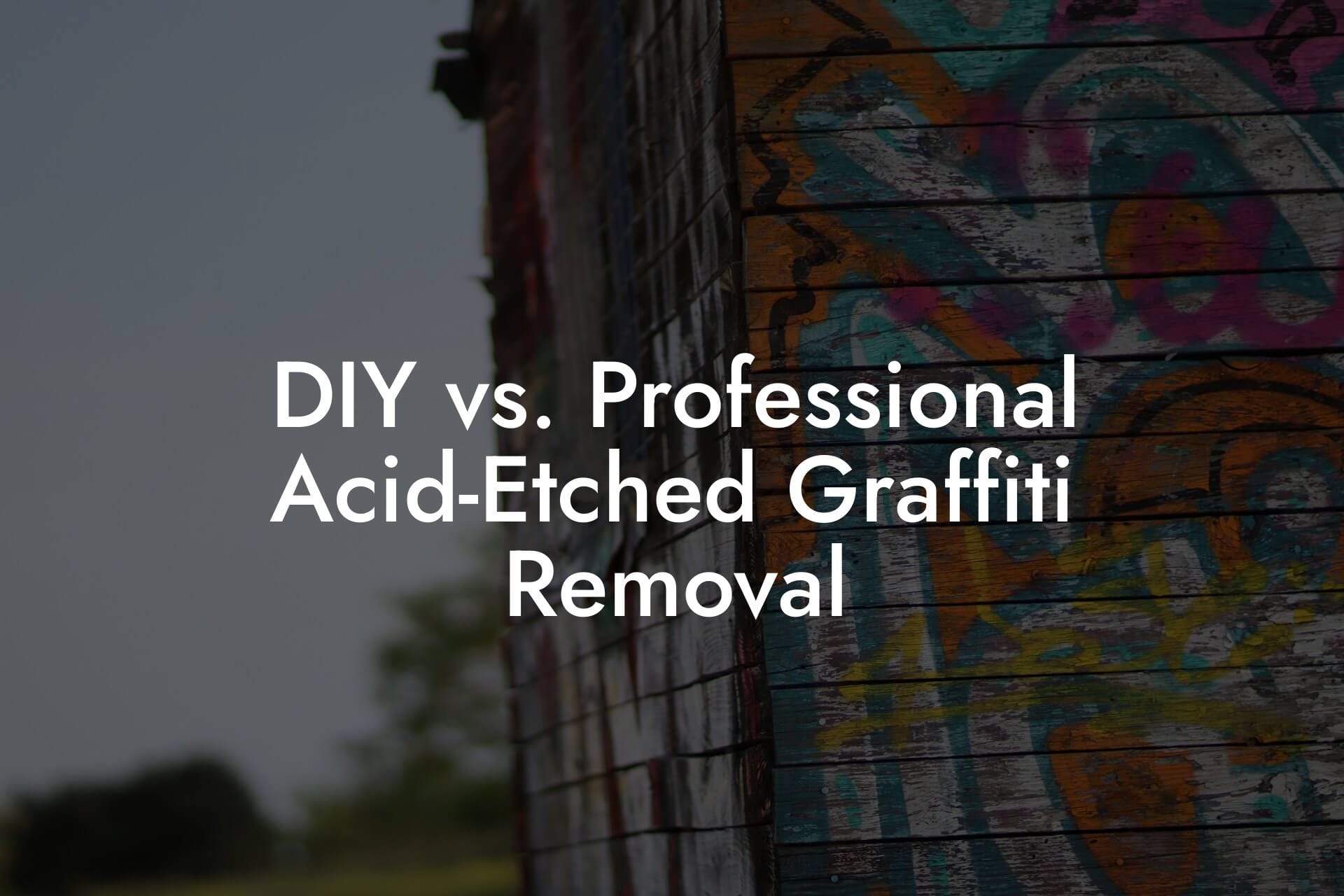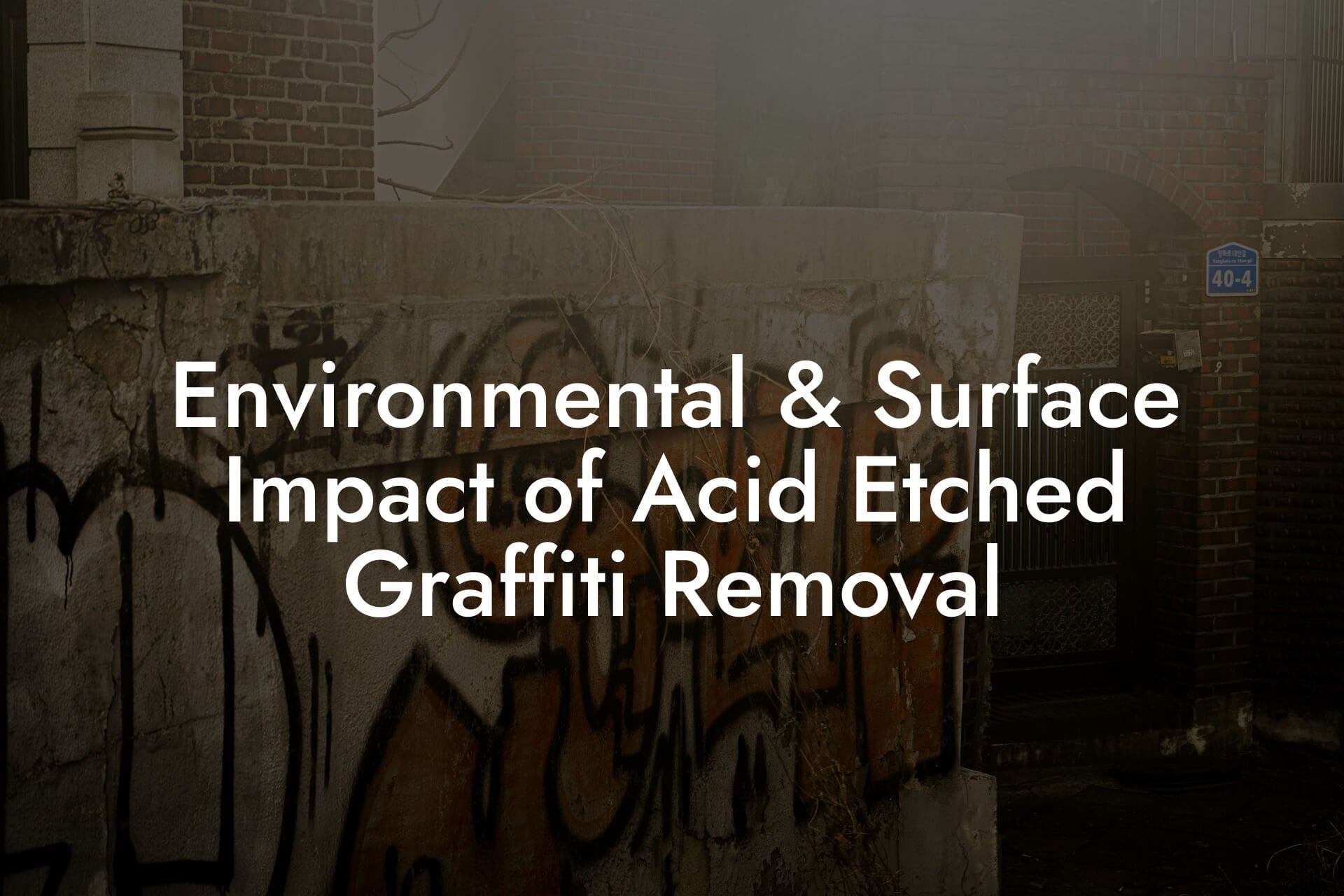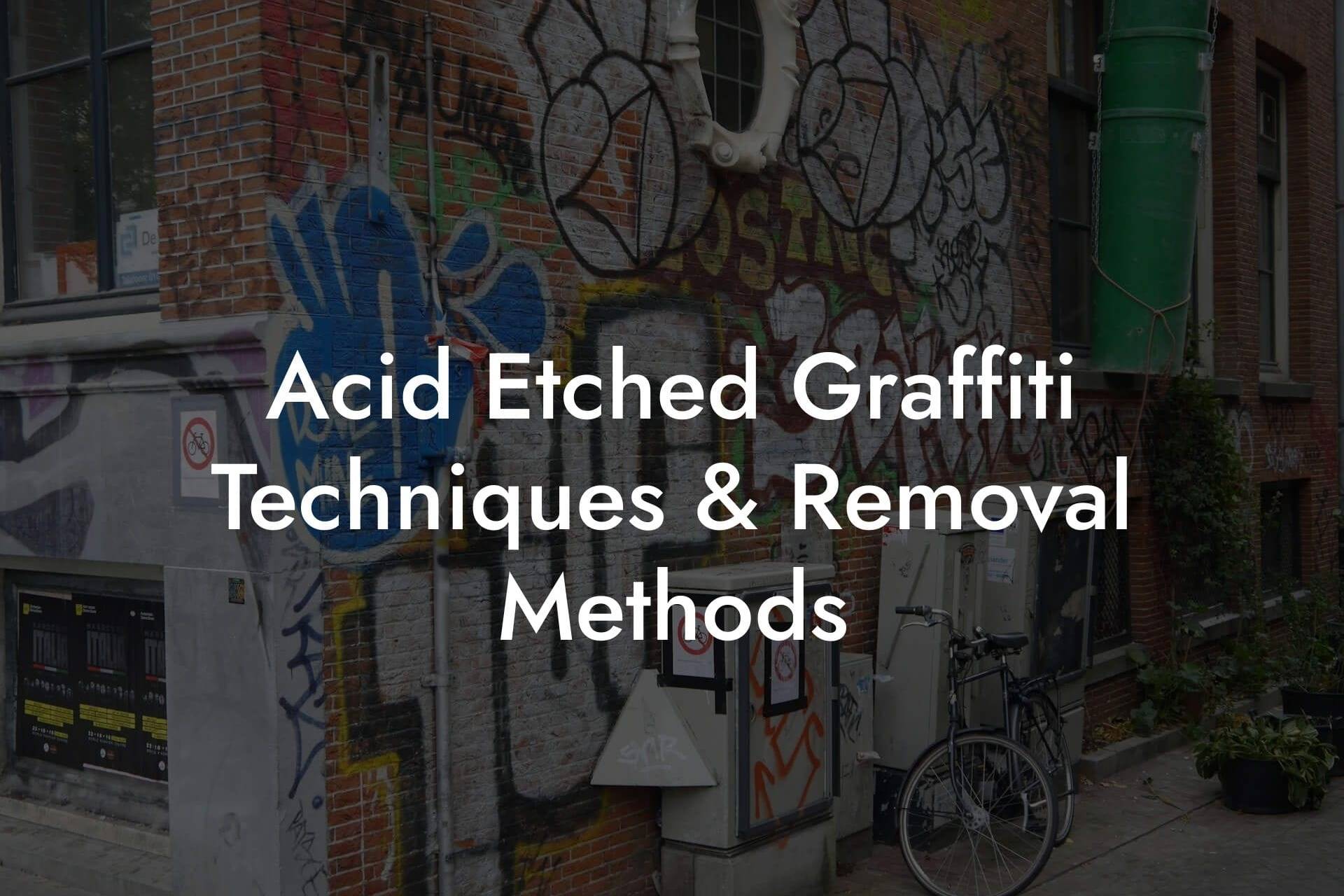Acid‑etched graffiti leaves permanent scars that resist standard cleaning methods, undermining facades, pavements, monuments and public art. While rapid acid etched graffiti removal remains essential, the most effective strategy combines prevention with specialized protective coatings. This comprehensive guide explores a full spectrum of anti‑etch measures, from surface preparation and barrier films to penetrating sealers and advanced nano‑technologies, equipping property owners, facilities managers and heritage custodians with the knowledge to safeguard substrates against future chemical vandalism. You’ll learn how to evaluate material vulnerabilities, select optimal coatings, apply them correctly, maintain long‑term performance and measure return on investment.
Table of Contents
- Understanding Acid Etch Vulnerabilities
- Assessing Surface Condition and Preparation
- Sacrificial Coatings as First‑Line Defense
- Penetrating Silane and Siloxane Sealers
- Epoxy and Polyurethane Barrier Coatings
- Nano‑Ceramic and Hydrophobic Coatings
- Comparative Performance and Selection Criteria
- Application Best Practices for Maximum Protection
- Maintenance, Monitoring and Reapplication
- Environmental and Safety Considerations
- Cost Analysis and Return on Investment
- Real‑World Case Studies
Understanding Acid Etch Vulnerabilities
Before selecting any preventive or protective treatment, it’s vital to understand why certain substrates are prone to acid etching. Natural stones such as limestone, sandstone and marble contain carbonate minerals that react readily with strong acids, producing soluble salts and leaving pits. Concrete and mortar, with their complex calcium silicate hydrates, similarly erode under acid attack. Even non‑porous materials, polished granite, ceramic glazes and metals, can sustain surface pitting or coating degradation when exposed to hydrofluoric or muriatic acids. Identifying the chemical composition, porosity, surface finish and existing sealers on a given substrate informs both the choice of protective chemistry and the necessary surface preparation techniques.
Assessing Surface Condition and Preparation
Effective deterrence begins with meticulous surface assessment and preparation. All substrates must be clean, dry and free of residual etch salts or contaminants. A multi‑step protocol often includes:
- Neutralization: Treat any residual acid with an alkaline wash such as a sodium bicarbonate slurry, allow dwell time, then rinse thoroughly with deionized water.
- Salt Extraction: Use poulticing or repeated water flushes to draw soluble salts from porous substrates, preventing future efflorescence under coatings.
- Drying: Ensure moisture content is below recommended thresholds (typically <5%) by using infrared hygrometers or moisture probes.
- Surface Profiling: For smoother adhesion, light abrasion, micro‑sandblasting or acid etch profiling may be required on concrete, metal or glazed surfaces.
Only after this thorough preparation can protective coatings perform optimally, bonding uniformly and creating an effective barrier against future acid penetration.
Sacrificial Coatings as First‑Line Defense
Sacrificial coatings create a distinct, peelable layer that absorbs graffiti and acid damage. After vandalism, the coating is stripped and reapplied, leaving the underlying substrate untouched. Key attributes include:
- Composition: Water‑based acrylic or polymer blends with controlled thickness (100–300 microns) and UV stability.
- Application: Spray or roller application in two coats, totaling 150–200 microns, ensuring full coverage of joints and crevices.
- Removal: Peels off in sheets when exposed to warm water or proprietary removal agents, facilitating quick restoration.
- Re‑application: New coats can be applied immediately after substrate cleaning, minimizing downtime.
Sacrificial systems offer high flexibility and minimal visual alteration, making them ideal for heritage stone, brickwork and public art installations where preservation of original appearance is paramount.
Penetrating Silane and Siloxane Sealers
Deeply penetrating silane and siloxane sealers chemically bond within substrate pores, forming a hydrophobic and oleophobic barrier that repels liquid acids and waterborne contaminants. Their advantages include breathability, UV resistance and minimal surface sheen alteration. Considerations for selection:
- Molecular Size: Silanes (<6 Å) penetrate up to 20 mm; siloxanes (oligomers) sit closer to the surface, providing robust water‑shedding.
- VOC Content: Opt for low‑VOC, water‑based formulations (<100 g/L) to reduce environmental impact and odor during application.
- Coverage Rates: Typical consumption ranges from 5 to 15 m² per liter, depending on porosity and surface roughness.
- Reapplication Interval: Most products warrant 3–5 years of protection; high‑traffic or exposed façades may require sooner maintenance.
Thanks to their invisibility and durability, silane/siloxane sealers are the workhorse for acid‑etch prevention on stone façades, concrete walls and mortar joints.
Epoxy and Polyurethane Barrier Coatings
For substrates requiring an impermeable barrier, such as concrete pits, steel cladding or glazed tiles, epoxy and polyurethane coatings provide robust protection. Their features include:
- Thickness: Film builds of 150–500 microns minimum, creating a hard, non‑porous shell.
- Chemical Resistance: High resistance to acids, solvents and salts; especially 100% solids epoxy formulations.
- UV Stability: Polyurethane topcoats are often applied over epoxy primers to resist yellowing and chalking.
- Surface Preparation: Requires grit blasting or acid etching to achieve an anchor profile for adhesion.
While offering superior long‑term protection, epoxy/polyurethane systems alter the substrate’s appearance more significantly and may not be suitable for listed or historically sensitive structures without regulatory approval.
Nano‑Ceramic and Hydrophobic Coatings
Recent advances in nanotechnology have yielded ceramic-based, superhydrophobic coatings that combine water‑beading with self‑cleaning properties. Key benefits include:
- Lotus‑Effect Surface: Water droplets roll off at low contact angles, carrying dirt and dilute acids away.
- Thin‑Film Application: 10–50 micron thickness, preserving original texture and color.
- Durability: Laboratory tests show resistance to pH 1 solutions and sustained water immersion.
- Eco‑Safety: Many formulations are solvent‑free and certified non‑toxic.
Though higher in upfront cost (typically £20–£50 per m²), nano‑ceramic coatings deliver exceptional longevity and minimal maintenance, making them attractive for high‑value installations and engineered stone.
Comparative Performance and Selection Criteria
Choosing the optimal protective system involves balancing factors such as substrate sensitivity, visual impact, expected acid exposure frequency and maintenance capabilities. A comparative matrix might consider:
- Longevity: Epoxy/polyurethane (10–15 years) > silane/siloxane (3–5 years) > sacrificial (1 year) > nano‑ceramic (5–10 years).
- Visual Impact: Silane/siloxane ≈ nano‑ceramic (invisible) < sacrificial < epoxy/polyurethane.
- Maintenance Ease: Sacrificial (peel/reapply) > silane/siloxane (recoat) > nano‑ceramic (periodic rinse) > epoxy/polyurethane (full system recoating).
- Cost per m²: Silane/siloxane (£5–£15) < sacrificial (£10–£25) < nano‑ceramic (£20–£50) < epoxy/polyurethane (£25–£40).
By mapping project priorities against these metrics, property managers can tailor a hybrid approach, combining durable barriers in hotspots with penetrating sealers elsewhere, to optimize both budget and performance.
Application Best Practices for Maximum Protection
Successful coating application hinges on strict adherence to manufacturer guidelines and environmental conditions:
- Temperature and Humidity: Apply within specified ranges (often 5–30 °C, <80% RH) to ensure proper cure.
- Substrate Profiling: Mechanically abrade or grit blast non‑porous surfaces to SA 2.5 standard for epoxy systems; acid etch profiling may suffice for silicone‑based sealers.
- Uniform Coverage: Use low‑pressure spray, roller or brush techniques as recommended; overlap passes by 50% to avoid pinholes.
- Curing Time: Allow full cure (24–72 hours) before any water or graffiti exposure; follow time‑temperature superposition rules for cold or damp sites.
- Quality Assurance: Conduct pull‑off adhesion tests, water‑beading angle measurements and holiday detection (for barrier films) to verify uninterrupted coverage.
Proper application not only maximizes coating life but prevents premature failure that could exacerbate substrate deterioration.
Maintenance, Monitoring and Reapplication
No protective system is truly permanent; proactive maintenance maintains resilience against acid attacks:
- Routine Inspections: Quarterly visual checks to identify coating wear, pinholes or loss of hydrophobic action.
- Scheduled Cleaning: Low‑pressure rinse with neutral pH detergents removes surface grime and dilute acid residues.
- Performance Testing: Annual water contact angle measurements (>100° for hydrophobic systems) and adhesion pull‑off tests (>1.5 MPa for barrier coatings).
- Reapplication Planning: Based on test results, plan recoating or sacrificial film replacement before protection falls below critical thresholds.
Integrated maintenance schedules and digital record‑keeping ensure that protective measures stay ahead of potential acid vandalism, reducing long‑term costs and downtime.
Environmental and Safety Considerations
When selecting and applying protective coatings, environmental impact and technician safety must be paramount:
- Low‑VOC Formulations: Minimize airborne pollutants and odor complaints, especially in enclosed or residential areas.
- Biodegradability: Favor water‑based, biodegradable polymers to reduce long‑term ecological footprint.
- Personal Protective Equipment: Ensure applicators use chemical‑resistant gloves, respirators and eye protection, especially with two‑component epoxies or solvent‑borne sealers.
- Waste Management: Collect and dispose of all wash‑water, masking films and mixer residues according to local regulations to prevent environmental contamination.
By integrating green chemistry principles with robust safety protocols, organizations can achieve both high performance and environmental stewardship.
Cost Analysis and Return on Investment
While protective coatings add upfront expense, the long‑term savings from reduced removal cycles, extended substrate life and lower maintenance can yield strong returns:
- Preventive vs. Reactive: A £10 / m² silane sealer that extends removal intervals from annually to once every five years saves approximately £30–£50 per removal cycle.
- Asset Preservation: Heritage stone replacement costs (£150–£500 per m²) far exceed coating investments, protecting original fabric and value.
- Operational Efficiency: Minimizing emergency call‑outs and disruptive restoration frees staff and tenant time, translating to intangible productivity gains.
Comprehensive life‑cycle costing models demonstrate that strategic coating programs often pay for themselves within two to three reapplication cycles, making them a prudent financial as well as technical choice.
Real‑World Case Studies
Historic Church in East London: A Georgian church suffered repeated acid etching on its Bath stone plinths. A hybrid approach, silane sealing on lower courses and sacrificial coating on exposed ledges, reduced etch incidents by 80% over two years, cut maintenance costs by 60%, and preserved original stonework under ecclesiastical heritage regulations.
Commercial Underpass in Southwark: A heavily trafficked pedestrian tunnel was targeted nightly. Nano‑ceramic hydrophobic treatment combined with quarterly sacrificial film application deterred graffiti and acid attacks. Maintenance crews reported 90% less acidic runoff, improved lighting reflectance and a 70% drop in remediation budgets.
University Campus Facade: Sandstone walls on a student union building saw frequent tagging. An epoxy primer topped with a UV‑resistant polyurethane finish created an impervious barrier. While altering stone texture, the system provided a five‑year guarantee, streamlined cleaning and prevented any acid penetration during its service life.
Combining rigorous surface preparation with the right protective coatings offers the most reliable defense against acid‑etched graffiti. Whether through sacrificial layers that peel away, penetrating silane barriers that repel liquids, durable epoxy shells or cutting‑edge nano‑ceramics, each system delivers unique performance characteristics suited to specific substrates and exposure levels. Careful selection based on substrate chemistry, aesthetic requirements, environmental constraints and maintenance capabilities ensures maximum longevity and cost efficiency. By implementing structured application protocols, scheduled inspections, environmental safeguards and maintenance planning, organizations can protect their built assets, reduce reactive restoration expenses and preserve architectural heritage for generations to come.
Toby Doherty
Toby Doherty is a seasoned graffiti removal expert with over 20 years of experience in the industry. Throughout his career, Toby has helped countless businesses and property owners in London maintain clean, graffiti-free spaces. His extensive knowledge of graffiti removal techniques, from eco-friendly solutions to advanced technologies like laser cleaning, makes him a trusted authority in the field. Passionate about restoring urban environments, Toby combines his hands-on expertise with a commitment to staying up-to-date on the latest industry trends and innovations. When he’s not out in the field, Toby shares his insights through detailed articles, offering practical advice on everything from graffiti prevention to legal considerations.



